1.类名前面可加public也可不加,加了保存的文件名必须为类名。
2.由1可知,一个文件里面最多只能有一个(最外层)类是public,否则文件名是什么呢?
3.
package fuxi1;
public class Main {
public class test
{
}
public static void main(String args[])
{
System.out.println("2");
}
}
一个文件里面可以有两个public类,但除了一个之外,其余都是内部类。
package fuxi1;
class Main {//4.所有外层的类可以不是public:
class test
{
}
public static void main(String args[])//5.但是main函数必须是public,且必须是static,否则怎样运行main呢?
{
System.out.println("2");
}
}
public static void main(String args[])不能返回int,记住形参表!!!
7.
package fuxi1;
import java.util.Scanner;
class Main {
class test
{
}
public static void main(String [] args)
{
Scanner sc=new Scanner(System.in);
while(sc.hasNext())//hasNext() ,如果如果读取的是整数可以是 hasNextint();
{
String ss=sc.next();//空格和回车会使之断开,当然按了一个回车就是有输出了,类似于c++的cin
System.out.println(ss);
for(int i=0;i<ss.length();i++)//ss.length是错误的
{
char x=ss.charAt(i); //String类型不能直接输出ss[i],需要ss.charAt(i),即String对象名.charAt(下标);
// System.out.println("ss("+i+")is"+ss[i]+"");
System.out.println("ss("+i+")is'"+x+"'");//输出的时候""自动成为一个String类型。在里面可以用+连接其他类型 。
}
}
}
}
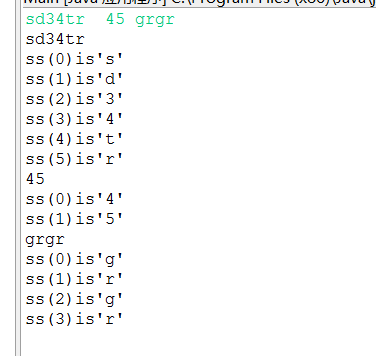
8.
import java.util.Scanner;
public class Main {
public static void main(String args[])
{
String[] ss={"sddssd","dfsfcce","2323fdf"};//一种可行的数组定义方法
System.out.println(ss);
System.out.println(ss.length);//字符串数组的字符串个数
//System.out.println(ss.length());是错误的,这个length()只能用于单个字符串
for(int i=0;i<ss.length;i++)//ss.length是错误的
{
System.out.println("ss("+i+")is'"+ss[i]+"'");
}
}
}
9.

,点击sd的时候,运行的是sd里面的main
10.
package fuxi1;
import java.util.Scanner;
public class sd {
public static void main(String [] args)
{
int ret=7;//变量名开头可以使字母,下划线和$
int _sdsd;
// int 23ere;///变量名开头不能是数字
// int $sd_32@#sd;//绝对不能出现 # %
int $sd_32$$sd;//变量除了开头,其他地方可以使数字,字母,下划线,$
// int %dsd=3;
// int *dsd=3;
// int sdsd sdsd=2;//不能出现空格
// System.out.println(_sdsd);//没有初始化是不能编译通过的。
System.out.println(ret);
}
}
11.
关键字和保留字:
java中没有sizeof 运算符。
两个保留字:
goto 和 const
关键字和保留字都是小写的
12.
java中的数据类型
分为基本类型和复合类型:
复合类型:包括字符串,数组,类,和接口。
13.
package fuxi1;
import java.util.Scanner;
public class sd {
public static void main(String [] args)
{
int ret=012;//0开头表示8进制
int a=0x3f;//0x开头表示16进制,都是0不是o
System.out.println(ret);
System.out.println(a);
}
}
14.
package fuxi1;
import java.util.Scanner;
public class sd {
public static void main(String [] args)
{
double ret=2e3;//
double b=2E3;//大小写e均可
double a=3.844;//默认为double
//int c=3.855;//错误,浮点型不能复制给整形
double c=3.855F;
double d=3D;//然而整形可以赋值给浮点型
long e=1230254905943059435L;
//long f=1230254905943059435;错误会提示超出了范围
System.out.println(ret);
System.out.println(a);
System.out.println(b);
System.out.println(c);
System.out.println(d);
System.out.println(e);
}
}
15.java中%运算符可以用于浮点型
package fuxi1;
import java.util.Scanner;
public class sd {
public static void main(String [] args)
{
double a=3%1.6;
double b=3.5%3;
double c=3.3%1.6;
System.out.println(a);
System.out.println(b);
System.out.println(c);
}
}

16.
package fuxi1;
import java.util.Scanner;
public class sd {
public static void main(String [] args)
{
double a=3%1.6;
double b=3.5%3;
double c=3.3%1.6;
// System.out.println(String.format("%lf+%lf",a,b));不能用%lf 用%f
System.out.println(String.format("%f+%f",a,b));
System.out.printf("%f+%f\n",a,b);
}
}

17.
if和while中必须使用条件句,c++中可以有while(n--)
但是java中等效的写法是 while(n--!=0)
18.
变量不经过初始化,不能通过编译。
package fuxi1;
public class test4 {
static public void main(String args[])
{
int [] s1,s2;
int a1[],a2;//a2是变量,a1是数组名,此时的a1没有只想任何地址
s1=new int [5];
//s2=6;错,s2是数组
a2=3;
a1=new int [a2];//如果有后面的a1=s1,这句话就无效了。
s1[0]=7;
s1[3]=9;
//s2[0]=1;错误,线必须让s2指向一个地址
s2=new int [a2];
s2[0]=3;
a1=s1;//因为a1和s1指向的地址相同,所以a1[0]=s1[0];
System.out.println(String.format(s1[0]+" "+s2[0]+" "+a1[0]+" "+a2));
System.out.println(String.format(s1[0]+" "+s2[0]+" "+a1[3]+" "+a2));//虽然
}
}
19.
package fuxi1;
public class test5 {
static public void main(String args[])
{
//int [5] a={1,2,3,4,5};//数组声明的时候不能在等号左边写数组大小
//int c[5]={1,2,3,4,5};
int [] b={1,2,3,4,5};
//int [] d=new int [5]{1,2,3,4,5};后面注明了每个元素,等号右边的括号不必注明数组大小,是不能!!!
int [] e=new int []{1,2,3,4,5};
for(int x:b)//for(type varname:arrayname)for-each循环只能进行读操作
{
System.out.println(x);
}
}
}
结果:
1
2
3
4
5
20.
package fuxi1;
public class test6 {
static public void main(String args[])
{
int [] b={1,2,3,4,5};
System.out.println(b.length);
//System.out.println(b.length());错的
}
}
5
<pre name="code" class="java">package fuxi1;
import java.util.Arrays;
import java.util.Scanner;
public class test7 {
public static void main(String args[])
{
String s=new Scanner(System.in).next();
System.out.println(s);
char []a={'3','j','e',' ','d'};
String s2=a.toString();//通过对象实例化来调用该函数//这种方法好像不行
System.out.println(s2);
int []b={3,4,5,6,7};
s2=Arrays.toString(b);//类的静态函数//这个方法似乎可以
System.out.println(s2);
int d=3;
//s2=d.toString();//不能调用基本类型 int 的 toString()
}
}
package fuxi;
import java.util.Arrays;
import java.util.Scanner;
public class test5 {
public static void main(String args[])
{
char []a={'3','j','e',' ','d'};
String s2=new String(a);//通过对象实例化来调用该函数
System.out.println(s2);
char []c=s2.toCharArray();//只能转化成char数组,不能为转化成int数组
for(char x:c)
{
System.out.print(x);
}
System.out.println();
double d=23.56;
int k=23;
s2=String.valueOf(d);//类名.方法 ,类名.valueOf();
String s=String.valueOf(k);
//String s="d";//局部变量 s 重复
System.out.println(s);
System.out.println(s2);
s=Integer.toString(k);
System.out.println(s);
s=""+k;
System.out.println(s);
}
}
22.
package fuxi1;
public class test8 {
public static void main(String args[])
{
int [][] a=new int[5][];//=左边不可以写大小,可以认为左边只是代表形式
//int [5][] a=new int[][];//错,=左边不可以写大小,可以认为左边只是代表形式
a[0]=new int [3];
a[1]=new int []{1,2,3};//[]不可以掉
//可以先分配第一维,再分配第二维。
//a[1]=new int {1,2,3};//错,[]不可以掉
//错啦!int b[3][2]={ {1,3},{2,4},{3,4}};
int c[][]={ {1,3},{2,4,7},{3,4}};
for(int []x:c)//for(int x[]:c)均可
{
for(int y:x)
{
System.out.print(" "+y);
}
System.out.println();
}
}
}

23.
package fuxi;
public class fuxi1 {
int x,y;
fuxi1()
{
x=y=0;
//x=0,y=0;java里面竟然不能这么写。
}
fuxi1(int t)
{
this();//构造函数互相调用,调用了this时this必须是第一句。
x=t;
}
void show()
{
System.out.println("x="+x+",y="+y);
}
public static void main(String args[])
{
fuxi1 a=new fuxi1();
//fuxi1 a=new fuxi1;
a.show();
//fuxi1 b=fuxi1(); c++中这种写法是允许的,这里不允许
fuxi1 b=new fuxi1(3);
b.show();
}
}
24.一个源文件最多只能有一条package命令,且必须放在源文件的最前面。
25.
package fuxi;
public class fuxi2 {
int s=2;
static int a=2;
int f()
{
return 3;
}
static int f2()
{
return 4;
}
public static void main(String args[])//静态函数调用静态方法和静态对象
{
//System.out.println(s);不能对非静态字段 s 进行静态引用
System.out.println(a);
//System.out.println(f());不能对类型 fuxi2 中的非静态方法 f()进行静态引用
System.out.println(f2());
}
class T
{
int d;
T(){d=s;}//因为不是静态的,所以这里可调用s
}
}
结果:
2
4
26.
package test;
import fuxi.fuxi1;//在不同包中,所以要导入
public class test1 {
public static void main(String args[])
{
fuxi1 a=new fuxi1();//构造函数 fuxi1()不可视,默认为default,需要把fuxi1的构造函数声明为public
System.out.println(a.x);//字段 fuxi1.x 不可视,需要把int x改为public int x;
//此外,fuxi1要声明为public,不能只声明要用的变量和函数
}
}


27.
package fuxi;
//此时fuxi3和fuxi1在同一个包中,也不需要导入fuxi1这个包
public class fuxi3 {
public static void main(String args[])
{
fuxi1 a=new fuxi1(3);//因为在同一个包中,默认为default,default对同一个包的类可视,不需要把fuxi1的构造函数声明为public
System.out.println(a.x);//因为在同一个包中,默认为default,不需要把int x改为public int x;
}
}
3
28.
| private成员 | 默认成成员 | protected成员 | public成员 | |
| 同一类中可见 | 是 | 是 | 是 | 是 |
| 同一类中对子类可见 | 否 | 是 | 是 | 是 |
| 同一个包中对子类可见 | 否 | 是 | 是 | 是 |
| 不同包中对子类可见 | 否 | 否 | 是 | 是 |
| 不同包中对非子类可见 | 否 | 否 | 否 | 是 |
说明:
private成员只对自己可见
默认成员对同一包中成员可见
protected在默认的技术上,加上对所有类的子类可见
public 对所有类均可见
29.
package fuxi;
import test.test1;//import 包名.类名
public class test2 extends test1{//继承关键字是extends不是extend
public static void main(String args[])
{
//test2 a= new test1(); //类型不匹配:不能从 test1 转换 为 test2;子=new 父()不行的
test1 b= new test2(); //父=new 子() 可以,这里没有写test2的构造函数,却有默认构造函数,即无参数的
System.out.println(b.x);
}
}
/*
package test;
import fuxi.fuxi1;//在不同包中,所以要导入
public class test1 {
public int x,y;
/*
test1(int x,int y):x(x),y(y) java里不能这么搞
{
}*/
public test1(int x) //注意这三个构造函数的顺序
{
this(0,0);
}
public test1(int x,int y)
{
this.x=x;
this.y=y;//java 里面没有指针,所有改用指针的地方均可用.,这里本来就该用.
}
public test1()
{
this(0,0);
}
/*
public static void main(String args[])
{
fuxi1 a=new fuxi1();//构造函数 fuxi1()不可视,默认为default,需要把fuxi1的构造函数声明为public
System.out.println(a.x);//字段 fuxi1.x 不可视,需要把int x改为public int x;
}*/
}
*/
30.
这证明一个类的修饰只能使public、final、abstract
而且abstract和final不能同时使用
package test;
private class test2 {//类 test2 的修饰符不合法;只允许使用“公用”、“抽象”和“终态”
}
package test;
public final abstract class test2 {//类 test2 的修饰符不合法;只允许使用“公用”、“抽象”和“终态”
//类 test2 可以是“抽象”或“终态”,但不能同时为“抽象”和“终态”
}
31.
以下两个是可行的
package test;
class test2 {//少了个public
public int x;
test2(){x=3;}
}
package test;
public class test3 {
public static void main(String args[])
{
int []a=new int[5];
test2 t=new test2();
System.out.println(t.x);
}
}
32.
错误的:
package fuxi;
import test.test2;//类型 test.test2 不可视,证明类前面不写是default
public class test4 {
}
package test;
class test2 {//类 test2 的修饰符不合法;只允许使用“公用”、“抽象”和“终态”
public int x;
test2(){x=3;}
//类 test2 可以是“抽象”或“终态”,但不能同时为“抽象”和“终态”
}
33.
对于缺省构造函数,隐式超构造函数 test2()不可视。必须定义显式构造函数:
package fuxi;
import test.test2;//类型 test.test2 不可视
public class test4 extends test2 {
}
package test;
public class test2 {
public int x;
test2(){x=3;}//这里加上public或protected就可以
}
34.
package test;
public class test2 {
public int x;
private int y;
public test2(){x=3;y=2;}
}
package test;
public class test5 extends test2{
void p()
{
System.out.println(x);
System.out.println(y);//字段 test2.y 不可视,因为y是private
}
}
35.
package test;
public class test2 {
public int x;
private int y;
void show() {
System.out.println(x);
}
public test2(){x=3;y=2;}
}
package test;
public class test5 extends test2{
void show() {
System.out.println(6);
}
void p()//覆盖
{
System.out.println(x);
}
public static void main(String args[])
{
test5 a=new test5();
a.show();
}
}
结果:
6
36.
package test;
public class test2 {
public int x;
private int y;
void show() {
System.out.println(x);
}
void show2() {
System.out.println(4);
}
public test2(){x=3;y=2;}
}
package test;
public class test5 extends test2{
void show() {
System.out.println(6);
}
void p()
{
System.out.println(x);
}
int show2() { //父类的show2函数是void,这里写int是不合法的
System.out.println(9);
}
public static void main(String args[])
{
test5 a=new test5();
a.show();
}
}

37.
子类方法不能缩小所覆盖方法的访问权限,覆盖方法不能比它所覆盖的方法访问性差。
错误的:
package test;
public class test5 extends test2{
private void show() { //不能降低自 test2 继承的方法的可视性
System.out.println(6);
}
public static void main(String args[])
{
test5 a=new test5();
a.show();
}
}
package test;
public class test5 extends test2{
public void show() {
System.out.println(6);
}
public static void main(String args[])
{
test5 a=new test5();
a.show();
}
}
38.
package test;
public class test2 {
public int x;
private int y;
void show() {
System.out.println(x);
}
void show2() {
System.out.println(4);
}
public test2(){x=3;y=2;}
}
package test;
public class test5 extends test2{
public void show() { //不能降低自 test2 继承的方法的可视性
System.out.println(6);
super.show();//注意父类的show()是被覆盖的函数
super.show2();//show2()没有覆盖,都可以用super
}
public static void main(String args[])
{
test5 a=new test5();
//a.super.show();super不是通过对象调用,实在一个类里直接调用
//也不能在main里面调用
a.show();
}
}
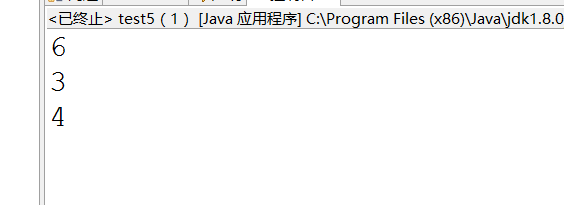
39.
当super用来显示调用父类构造函数时,必须放在子类构造函数的第一行。
构造函数(指的是super)调用必须是构造函数中的第一个语句
package test;
public class test2 {
public int x;
private int y;
test2(int x,int y)
{
this.x=x;
this.y=y;
}
void show() {
System.out.println(x);
}
void show2() {
System.out.println(4);
}
public test2(){x=3;y=2;}
}
package test;
public class test5 extends test2{
test5(){}
test5(int x,int y)
{
//int k;构造函数调用必须是构造函数中的第一个语句
super(x,y);
}
public void show() {
// super(x,y);构造函数调用必须是构造函数中的第一个语句
System.out.println(6);
super.show();
super.show2();
}
public static void main(String args[])
{
//super(x,y);构造函数调用必须是构造函数中的第一个语句
test5 a=new test5();
a.show();
}
}
40.
package newpack;
public class new1 {
int x,z;
public new1() {x=3;z=0;}
public new1(int x) {this.x=x;z=0;}
}
package newpack;
public class new2 extends new1 {
int y,z;
public new2()
{
y=6;
z=1;
}
public new2(int x)
{
super(x);
y=6;
z=1;
}
void show()
{
System.out.println(super.z);
System.out.println(z);
}
public static void main(String[] args) {
// TODO 自动生成的方法存根
new1 fa=new new2();
System.out.println(fa.x);
// System.out.println(fa.y);因为父类中没有y,y是子类的
//而fa是父类的一个对象,所以fa能访问的只是父类相关的部分,不能是子类相关的
new2 a=new new2();
a.show();
}
}
3
0
141.
public class new2 extends new1
public static void main(String[] args) {
new1 fa=new new2();
new2 a=new new2();
new1 b=new new1();
if(fa instanceof new1) System.out.println(1);
if(fa instanceof new2) System.out.println(2);
if(a instanceof new1) System.out.println(3);
if(a instanceof new2) System.out.println(4);
if(b instanceof new1) System.out.println(5);
if(b instanceof new2) System.out.println(6);
}结果:
1//这种特殊情况父类 父=new 子类() ,父即是父类实例又是子类实例
2//这种特殊情况父类 父=new 子类() ,父即是父类实例又是子类实例
3//子类对象是父类的实例
4//子类对象是子类的实例
5//父类对象是父类的实例
//父类对象不是子类的实例42.
package newpack;
public class new2 extends new1 {
int y,z;//有两个z,super.z是父类的z,普通的z是子类覆盖掉的z
public new2()
{
y=6;
z=1;
}
public new2(int x)
{
super(x);
y=6;
z=1;
}
void show()
{
System.out.println(super.z);
System.out.println(z);
}
public static void main(String[] args) {
// TODO 自动生成的方法存根
new1 fa=new new2();
new2 a=new new2();
new1 b=new new1();
//fa.show();//没有为类型 new1 定义方法 show(),show()是子类才有的功能
new2 t=(new2)fa;//证明fa可以强制转换赋值到子类对象上恢复 其原来的功能,证明fa有'内//力'啊
t.show();
// (new2)fa.show();这个写法是错误的
}
}
0
1
43.
package newpack;
public class new1 {
int x,z;
public new1() {x=3;z=0;}
public new1(int x) {this.x=x;z=0;}
static void show()
{
System.out.println("this is show");
}
void show2()
{
System.out.println("this is show2");
}
}
package newpack;
public class new2 extends new1 {
int y,z;//有两个z,super.z是父类的z,普通的z是子类覆盖掉的z
public new2()
{
y=6;
z=1;
}
public new2(int x)
{
super(x);
y=6;
z=1;
}
static void show()//如果要覆盖父类的static函数,这里也需要static
{
System.out.println("this is show");
}
void go()
{
System.out.println("go");
}
static void go2()
{
System.out.println("go2");
}
static new2 c=new new2();
public static void main(String[] args) {
// TODO 自动生成的方法存根
new1.show();
//new1.show2();//不能对类型 new1 中的非静态方法 show2()进行静态引用
new1 a=new new1();
a.show2();
a.show();
//go();//不能对类型 new2 中的非静态方法 go()进行静态引用
go2();
new2 b=new new2();
b.go();//可以
c.go();//可以,所以静态关键是注意顺序问题
}
}
44.
package newpack;
public abstract class new1 {
int x,z;
public new1() {x=3;z=0;}
public new1(int x) {this.x=x;z=0;}
static void show()
{
System.out.println("this is show");
}
// abstract void t();抽象类中方法全部实现是可以的
abstract void t();//没有花括号,打分号
void show2()
{
System.out.println("this is show2");
}
public static void main(String args[])
{
System.out.println("d");
}
}
45.
package newpack;
public abstract class new1 {
int x,z;
public new1() {x=3;z=0;}
public new1(int x) {this.x=x;z=0;}
static void show()
{
System.out.println("this is show");
}
// abstract void t();抽象类中方法全部实现是可以的
abstract void t();//没有花括号,打分号
void show2()
{
System.out.println("this is show2");
}
}
package newpack;
public class new2 extends new1 {//类型 new2 必须实现继承的抽象方法 new1.t()
public void t(){//这里只有加了public,才能在别的类中通过对象调用这个函数
System.out.println("go");
}
package test;
import newpack.new1;
import newpack.new2;
import fuxi.fuxi1;//在不同包中,所以要导入
public class test1 {
public static void main(String args[])
{
//new1 a=new new1();// 不能实例化类 型 new1
new2 b= new new2();
b.t();
}
}
go
46.接口内不能有变量,接口类不能有构造函数
抽象类可以有构造函数,
两者都不能被实例化
package newpack;
public abstract class new1 {
int x,z;
//抽象类中可以没有构造函数,接口里面必须没有
// abstract void t();抽象类中方法全部实现是可以的
abstract void t();//没有花括号,打分号
}
package newpack;
public class new2 extends new1 {//类型 new2 必须实现继承的抽象方法 new1.t()
public void t(){//这里只有加了public,才能在别的类中通过对象调用这个函数
System.out.println("go");
}
int y,z;//有两个z,super.z是父类的z,普通的z是子类覆盖掉的z
public new2()
{
y=6;
z=1;
}
}
47.
继承 extends
实现 implements
48.
package newpack;
public final class new1 {
int x,z;
}
package newpack;
public class new2 extends new1 {//类型 new2 不能成为终态类 new1 的子类
}
49.
package newpack;
public final class new1 {
int x,z;//谁说final类中的属性和方法都必须被final修饰符修饰
void showx(){System.out.println(x);}//<span style="font-family: Arial, Helvetica, sans-serif;">谁说final类中的属性和方法都必须被final修饰符 //修饰</span>
public static void main(String args[])
{
new1 a=new new1();
a.showx();
}
}
运行结果:
0
50.
package newpack;
interface new1 {
// int x,z;接口中不能有变量
static int x=3;
//static int y;//空白终态字段 y 可能尚未初始化,虽然没写final,但是确实是final,
//与一般的final不同,y必须初被显示初始化
static final int z=3;
final int w=3;//这里的w其实是静态变量,即static
void showx();//接口中的方法一个都不能实现
public static void main(String args[])
{
// new1 a=new new1();
//new1.x=45;//不能对终态字段 new1.x 赋值,
/*
接口中只能有全局静态常量
这里的new1.x不能赋值。
*/
//new1.w=3;//不能对终态字段 new1.w 赋值
System.out.println(new1.w);
}
}
结果:
3
51.java只支持但继承,不支持多继承
package newpack;
public class new2 implements new1{//类型 new2 必须实现继承的抽象方法 new1.showx()
public void showx()//不能降低自 new1 继承的方法的可视性,所以要用public,不能默认
{//interface 里面的方法默认都是公有和抽象的。
System.out.println(x);
}
public static void main(String args[])
{
new2 a=new new2();
System.out.println(a.x);
a.showx();
}
}
3
3
52.
多接口:
package newpack;
interface new3 {
void show3();
}
package newpack;
interface new1 {
void show();
}
package newpack;
public class new2 implements new1,new3{
public void show()
{
System.out.println("show");
}
public void show3()
{
System.out.println("show3");
}
public static void main(String args[])
{
new2 a=new new2();
a.show();
a.show3();
}
}
结果:
show
show3
53.内部类
package newpack;
public class outer {
private int size=1;
public class inner
{
private int size=2;
public void doStuff(int size)
{
System.out.println(size);
System.out.println(this.size);
System.out.println(outer.this.size);
//System.out.println(outer.size);
//不能对非静态字段 outer.size 进行静态引用只有静态才能这么高
}
}
static class inner2//只有内部类才能用static
{
}
class name
{
}
static void g()
{
//this.size;//不能在静态上下文中使用 this
}
public static void main(String args[])
{
//this.size;//不能在静态上下文中使用 this
}
}

package newpack;
public class ttt {
private int size=1;
public class inner
{
private int size=2;
public void doStuff(int size)
{
System.out.println(size);
System.out.println(this.size);
System.out.println(ttt.this.size);
//System.out.println(outer.size);
//不能对非静态字段 outer.size 进行静态引用只有静态才能这么高
}
}
static class inner2//只有内部类才能用static
{
}
class name
{
}
static void g()
{
//this.size;//不能在静态上下文中使用 this
}
public static void main(String args[])
{
//this.size;//不能在静态上下文中使用 this
}
}

编译后生成的class文件名为:
1.外部类名.class (对于外部类 q)
2.外部类名$内部类名.class (对于所有内部类)
54.
try{ } catch(异常类型 名){/*......*/}
package newpack;
public class ttt {
public static void main(String args[])
{
String []s={"ACM","ICPC","dfs"};
for(int i=0;i<4;i++)
{
System.out.println(s[i]);
}
}
}
package newpack;
public class ttt {
public static void main(String args[])
{
String []s={"ACM","ICPC","dfs"};
for(int i=0;i<4;i++)
{
try {System.out.println(s[i]);}
catch(Exception e)
// catch()括号里面要是什么都不写是错的
{
}
}
}
}

55.
package newpack;
public class ttt {
public static void main(String args[])
{
String []s={"ACM","ICPC","dfs"};
for(int i=0;i<4;i++)
{
try {
System.out.println(s[i]);
System.out.println("in");
}
catch(Exception e)
{
}
finally
{
System.out.println("working");
//不管是否有异常发生,这里代码都要执行。
}
System.out.println("visit");
}
}
}
结果:try{}catch(){}finally{}
ACM
in
working
visit
ICPC
in
working
visit
dfs
in
working
visit//这里少了个in,证明try里面异常抛出后后面的就不执行了
working//然后try外面的还是会继续执行,特别是finally肯定会执行
visit
56.try {} finally{}
package newpack;
public class ttt {
public static void main(String args[])
{
String []s={"ACM","ICPC","dfs"};
for(int i=0;i<4;i++)
{
try {
System.out.println(s[i]);
System.out.println("in");
}
finally
{
System.out.println("working");
//不管是否有异常发生,这里代码都要执行。
}
System.out.println("visit");
}
}
}
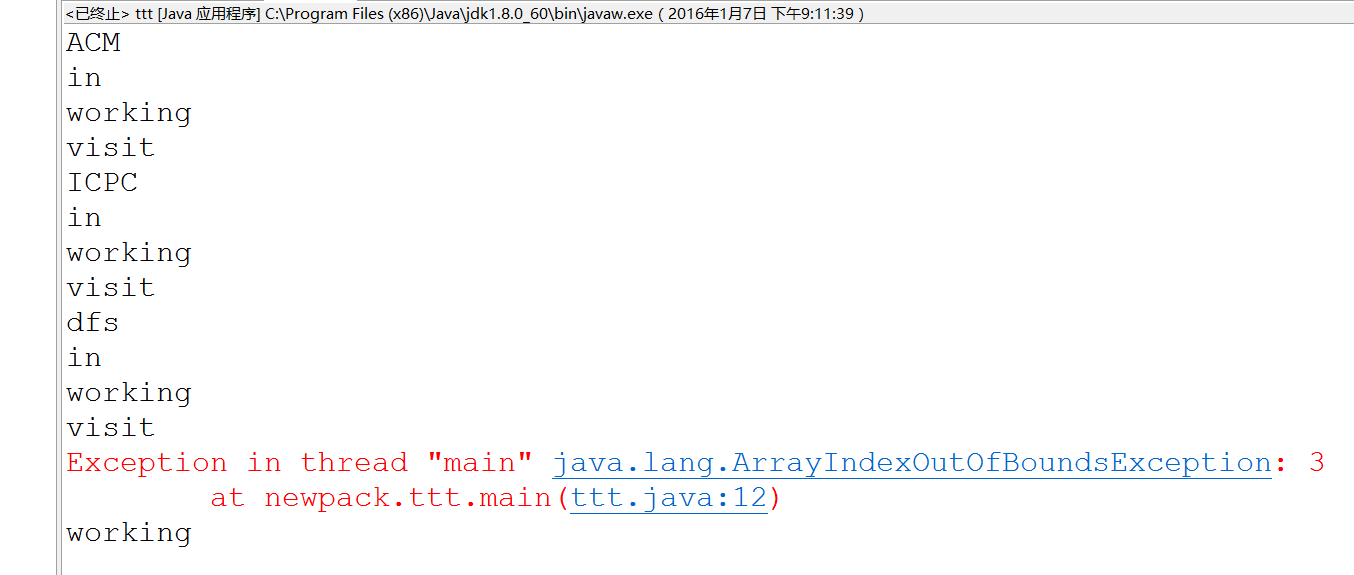
在i=3时,try抛出异常没有处理,所以会报错。
但是finally语句还是会执行。但是最后那一句不会执行,因为出错了。
57.放错位置
package newpack;
public class ttt {
public static void main(String args[])
{
String []s={"ACM","ICPC","dfs"};
for(int i=0;i<4;i++)
{
try {
System.out.println(s[i]);
System.out.println("in");
}
finally
{
System.out.println("working");
}
System.out.println("visit");
}
finally //finally放错了位置
{
System.out.println("working");
}
}
}
package newpack;
public class ttt {
public static void main(String args[])
{
String []s={"ACM","ICPC","dfs"};
for(int i=0;i<4;i++)
{
try {
System.out.println(s[i]);
System.out.println("in");
}
int x=3;//int隔断了try和catch
catch(Exception e)
{
}
finally
{
System.out.println("working");
}
System.out.println("visit");
}
}
}
package newpack;
public class ttt {
public static void main(String args[])
{
String []s={"ACM","ICPC","dfs"};
for(int i=0;i<4;i++)
{
try {
System.out.println(s[i]);
System.out.println("in");
}
catch(Exception e)
{
}
int z=3;//z隔断了finally
finally
{
System.out.println("working");
}
System.out.println("visit");
}
}
}
58.
可以多个catch并存,但只会有最近一个处理异常。
59.
package newpack;
public class ttt {
/*
extends implements throws
try catch才是真正意义上的异常处理
这个写法是直接向上层抛出
当前方法不处理异常,向上层抛出。
*/
public static void main(String args[])throws Exception//记住是throws不是throw
{
String []s={"ACM","ICPC","dfs"};
for(int i=0;i<4;i++)
{
System.out.println(s[i]);
System.out.println("in");
}
}
}

60.
package newpack;
public class ttt {
public static void main(String args[])throws Exception//记住是throws不是throw
{
String []s={"ACM","ICPC","dfs"};
Exception e=new Exception("抛出异常");
for(int i=0;i<4;i++)
{
// if(i==3) throw new Exception("抛出异常");这个写法是一样的,简便些
if(i==3) throw e;
System.out.println(s[i]);
System.out.println("in");
}
}
}
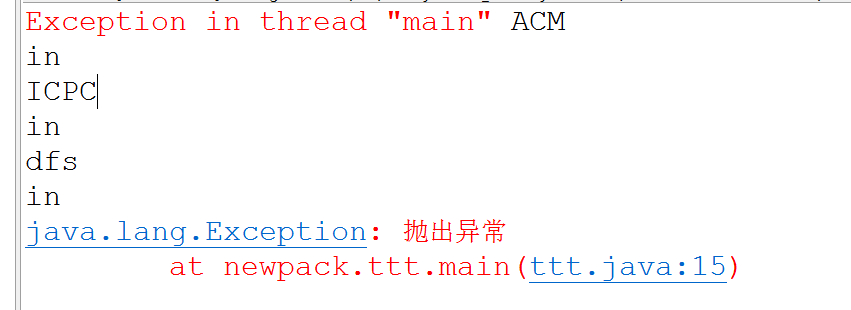
61.
package newpack;
public class ttt {
public static void main(String args[])
{
String []s={"ACM","ICPC","dfs"};
for(int i=0;i<4;i++)
{
try {System.out.println(s[i]);}
catch(Exception e)
{
try {
throw new Exception("抛出异常");
} catch (Exception e1) {
// TODO 自动生成的 catch 块
e1.printStackTrace();
}
/*
*
这可能是所谓的throw要么和try catch finally 配套使用
,要么和throws配套使用。
throws可以单独使用,但throw不能。
*/
}
}
}
}
62.
package newpack;
public class ttt {
public static void main(String args[])
{
String []s={"ACM","ICPC","dfs"};
for(int i=0;i<4;i++)
{
try {
if(i==4) throw new Exception("d");
}
catch(Exception e)
{
}
System.out.println(s[i]);
}
}
}结果为啥是这样????:
63.
package newpack;
public class ttt {
public static void main(String args[])
{
String a=new String("abc");
String b=new String("abc");
String c=a;
System.out.println(a==b);
System.out.println(c==a);
}
}
64.
package newpack;
public class Line {
public static class Point
{
}
}
class Triangle
{
//错 Point p=new Point();//Point 无法解析为类型
Line.Point p=new Line.Point();
//错 Line.Point p=Line.new Point();//Line cannot be resolved to a variable
/*错
Line l=new Line();
l.point p=new l.Point();
*/
/*错
Line l=new Line();
l.point p=l.new Point();
*/
}
65.
package fuxi2;
public class fuxi2
{
String s;
fuxi2(){}//如果不写这个,只有下面那个传参数String cc的构造函数,那么默认构造函数就被屏蔽了
public fuxi2(String cc)
{ }
void fun()
{
System.out.println(s);
}
public static void main(String args[])//String args[]掉了这句,引发大毛病
{
String cc="33";
fuxi2 a=new fuxi2();
fuxi2 b=new fuxi2(){};
fuxi2 c=new fuxi2(){ void fun(){System.out.println("6"); } };
fuxi2 d=new fuxi2(cc)//cc没有被用到,不写cc结果一样
{
//fuxi2(String s) {this.s=s;} 不能在这里创建构造函数
void fun(){System.out.println("6"); } //这个函数被覆盖了
};
a.fun();
b.fun();
c.fun();
}
}
66.
class Alpha
{
public void foo()
{
System.out.print("A");
}
}
class Beta extends Alpha
{
public void foo()
{
System.out.print("B");
}
}
public class test {
public static void main(String args[])
{
Alpha a=new Beta();
Beta b=(Beta) a;
a.foo();//父类的方法被覆盖了,输出"B"
b.foo();//恢复后的a赋值给b,恢复后的a的foo()方法还是子类的
}
}
BB67.
package fuxi2;
interface A {}
class B implements A{}
class C extends B{}
class D{}
public class test{
public static void main(String args[])
{
A a=new C();//a其实instanceof C,所以也instanceof A and B
C b=new C();
D d=new D();
if(a instanceof A) System.out.print("1");
if(a instanceof B) System.out.print("1");
if(a instanceof C) System.out.print("1");
if(b instanceof A) System.out.print("2");
if(b instanceof B) System.out.print("2");
if(b instanceof C) System.out.print("2");
if(d instanceof A) System.out.print("3");
//if(x instanceof X)只要x是X类的对象或者是X类子类的对象即可。
}
}
11122268.
public class test {
public static void main(String args[])
{
int s=6;
//s-=3+++s;不打空格为错
s-=3+ ++s;
System.out.println(s);
s=6;
//++s-=3+ ++s;//标记“++”上有语法错误,删除此标记
s+= ++s + ++s;//6 +7 +8;
System.out.println(s);
s=6;
// s++=s+ ++s;//赋值的左边必须是变量
s=s + ++s;//s=6+7;
System.out.println(s);
s=6;
s=s+++ ++s;//s= 6+7 +1;
System.out.println(s);
}
}
-4
21
13
14
69.
class Super
{
static String greeting()
{
return "Good night";
}
String greeting2()
{
return "Good night";
}
String name(){return "Tom";}
}
class Sub extends Super
{
static String greeting(){return "Hello";}//父类的静态方法,子类是覆盖不了的
// static String greeting2(){return "Hello";}//此静态方法不能隐藏 Super 中的实例方法,
//用静态盖住编译无法通过
String greeting2(){return "Hello";}//此静态方法不能隐藏 Super 中的实例方法
String name(){return "Mary";}
void show()
{
System.out.println(greeting());//这里是可以区分的
System.out.println(super.greeting());//这里是可以区分的
System.out.println(greeting2());//这里是可以区分的
System.out.println(super.greeting2());//这里是可以区分的
}
}
public class test {
public static void main(String args[])
{
Super s=new Sub();
System.out.println(s.greeting()+","+s.name());
System.out.println(s.greeting2()+","+s.name());
//s.show();//没有为类型 Super 定义方法 show(),s不能使用子类的方法
Sub t=new Sub();
t.show();
}
}
Good night,Mary
Hello,Mary
Hello
Good night
Hello
Good night
70.
class StaticInitDemo
{
static int i=1;
static
{
System.out.print(i++);
}
}
public class test {
public static void main(String args[])
{
System.out.println(StaticInitDemo.i);
}
}
12
71.
class StaticInitDemo
{
static int i=1;
static
{
System.out.print(i++);
}
}
public class test {
static
{
// l++;在定义字段之前不能引用该字段
k=8;
// k++;在定义字段之前不能引用该字段
}
static int k,l=3;
static
{
l++;
k=5;
}
static
{
l++;
k=9;
}//static 块按照出现的先后讲究次序
public static void main(String args[])
{
System.out.println(StaticInitDemo.i);
System.out.println(k);
}
}
12
9
72.
public class test {
// z:
public static void main(String args[])
{
for(int i=0;i<4;i++)
{
if(i==2) break;
System.out.println(i);
}
System.out.println( );
x:
for(int i=0;i<4;i++)
{
if(i==2) break x;
System.out.println(i);
}
System.out.println( );
x:
for(int i=0;i<4;i++)
{
y:
for(int j=0;j<4;j++)
{
if(j==3) break ;//跳出小循环
System.out.println(i+" "+j);
}
}
System.out.println( );
x:
for(int i=0;i<4;i++)
{
y:
for(int j=0;j<4;j++)
{
if(j==3) break y;//跳出小循环
System.out.println(i+" "+j);
}
}
System.out.println( );
x:
for(int i=0;i<4;i++)
{
y:
for(int j=0;j<4;j++)
{
if(j==3) break x;//break x,就是说大循环跳出了
System.out.println(i+" "+j);
}
}
System.out.println( );
x:
for(int i=0;i<4;i++)
{
y:
for(int j=0;j<4;j++)
{
if(j==2) continue y;//对于小循环 continue;
System.out.println(i+" "+j);
}
}
System.out.println( );
x:
for(int i=0;i<4;i++)
{
y:
for(int j=0;j<4;j++)
{
if(j==2) continue x;//对于大循环 continue;
System.out.println(i+" "+j);
}
}
}
}
0
1
0
1
0 0
0 1
0 2
1 0
1 1
1 2
2 0
2 1
2 2
3 0
3 1
3 2
0 0
0 1
0 2
1 0
1 1
1 2
2 0
2 1
2 2
3 0
3 1
3 2
0 0
0 1
0 2
0 0
0 1
0 3
1 0
1 1
1 3
2 0
2 1
2 3
3 0
3 1
3 3
0 0
0 1
1 0
1 1
2 0
2 1
3 0
3 1
73.
class Shape
{
}
class Rectangle extends Shape
{
}
class Square extends Rectangle
{
}
class Triangle extends Shape
{
}
public class test {
public static void main(String args[])
{
Triangle tr=new Triangle();
Square sq=new Square();
Shape sh=tr;
System.out.println(sh==tr);//sh和tr引用的内存空间是相同的,sh和tr引用同一个对象
String s="123";
//String a=(String)s;可以
String a=s;
System.out.println(a==s);
System.out.println(a.equals(s));
}
}
true
true
true
74.
class Shape
{
}
class Rectangle extends Shape
{
}
class Square extends Rectangle
{
}
class Triangle extends Shape
{
}
public class test {
public static void main(String args[])
{
Triangle tr=new Triangle();
Square sq=new Square();
Shape sh=tr;
Triangle ntr=tr;
// Triangle mtr=sh;//类型不匹配:不能从 Shape 转换为 Triangle
//即使sh(父类对象)是从tr(子类对象)赋值来的,但是在这里仍然不能作为子类对象赋值给子类。
sh=sq;//sq是sh所属类的子类的子类对象,这样仍可。
}
}
75.
public class test {
static boolean isPerfect(int a)
{
int s=0;
for(int i=1;i*i<=a;i++) if(a%i==0)
{
s+=i;
}
return s==a;
}
public static void main(String args[])
{
System.out.println(isPerfect(10));
}
}
76.
public class test {
static boolean isInvert(int a)
{
int s=0;
int x=a;
while(x>0)//注意java里面不能写while(x) ,while和if的()里必须写条件句
{
s=s*10+x%10;
x/=10;
}
return s==a;
}
public static void main(String args[])
{
System.out.println(isInvert(10));
System.out.println(isInvert(121));
System.out.println(isInvert(122));
System.out.println(isInvert(22122));
System.out.println(isInvert(32122));
System.out.println(isInvert(2122));
}
}
false
true
false
true
false
false
77.
public class test {
static int getlastnum(String s)
{
//if(s==NULL||s.length()==0) return -1;这里大写的NULL是错的,虽然c/c++中可以
if(s==null||s.length()==0) return -1;
char x=s.charAt(s.length()-1);
return '0'<=x&&x<='9'?x-'0':getlastnum(s.substring(0, s.length()-1) );
}
public static void main(String args[])
{
String s1;
String s2="";
// System.out.println(s1);//局部变量 s1 可能尚未初始化,这里无法使用
System.out.println(s2);
System.out.println(s2.length());
// getlastnum(s1);//局部变量 s1 可能尚未初始化
System.out.println(getlastnum(s2));
System.out.println(getlastnum("abc24us43"));
System.out.println(getlastnum("82445adb"));
System.out.println(getlastnum("ab"));
}
}
78.
abstract class Animal
{
protected String food;
Animal(String food){this.food=food;}
public abstract void eat();
}
class Dog extends Animal//(这句话当且仅当,出现Dog() 时且没用super()才会说)没有为缺省构造函数定义隐式超构造函数 Animal()。必须定义显式构造函数
{
Dog(String s)
{
super(s);
}
Dog()//未定义隐式超构造函数 Animal()。必须显式调用另一个构造函数
{
super("?");
}
public void eat()
{
System.out.println("狗吃"+food);
}
}
public class test {
public static void main(String args[])
{
Animal a1=new Dog("骨头");
Animal a2=new Dog();
a1.eat();//要求输出“狗吃骨头”
a2.eat();//要求输出“狗吃?”
}
}
狗吃骨头
狗吃?
79.
import java.io.*;
public class test {
public static void main(String args[])
{
InputStreamReader isr= new InputStreamReader(System.in);
BufferedReader br=new BufferedReader(isr);
//没有br.hasNext();
String s;
try {
s = br.readLine();
System.out.println(s);
br.close();//文件有关的操作都得放到try里面
isr.close();//文件有关的操作都得放到try里面
} catch (IOException e) {
}
//System.out.println(s);如果把try中的这句话放到这里会出现问题
}
}
80.
import java.io.*;
public class test {
public static void main(String args[]) throws ExceptionIOException亦可
{
BufferedReader br=new BufferedReader(new InputStreamReader(System.in));
//没有br.hasNext();
String s;
s= br.readLine();
System.out.println(s);
br.close();
}
}
81.
import java.io.*;
public class test {
public static void main(String args[])
{
//InputStreamReader isrr= new InputStreamReader(System.in);//这个不必用try
//BufferedReader brr=new BufferedReader(isrr); //这个不必用try
//没有br.hasNext();
String s;//s的声明放在try里面外面都行
try {
FileInputStream fis=new FileInputStream("E:\\ttt.txt");//字节流
//这样也行 :FileInputStream fis=new FileInputStream("E:/ttt.txt");//字节流
InputStreamReader isr= new InputStreamReader(fis);//字符流
BufferedReader br=new BufferedReader(isr);//缓存流
// while(s=br.readLine()!=null) s = br.readLine();
while((s=br.readLine())!=null)
{
System.out.println(s);
}
fis.close();
br.close();//文件有关的操作都得放到try里面
isr.close();//文件有关的操作都得放到try里面
} catch (IOException e) {
}
// s = br.readLine();//无法解析 br,因为br在{}里面,而且这句话一定要处理异常
//System.out.println(s);如果把try中的这句话放到这里会出现问题
}
}82.
import java.io.*;
public class test {
public static void main(String args[])
{
String s;
try
{//记住是BufferedWriter和BufferedReader不是Buffer
BufferedWriter bw=new BufferedWriter
(new OutputStreamWriter(new FileOutputStream("E:/tta.txt")));//没有会自动创建
BufferedReader br=new BufferedReader
(new InputStreamReader (new FileInputStream("E:\\ttt.txt") ) );
//因为有'\n'所以'\'要打两次,表示路径,或者用'/'
//注意区分Reader和Writer
while((s=br.readLine())!=null)
{
bw.write(s);//这样写不会换行。
// bw.write('\n');//加了这个没用
}
//Resource leak: 'bw' is never closed
//Resource leak: 'br' is never closed
bw.close();
br.close();
}
catch(Exception e)
{
}
}
}83.
import java.io.*;
public class test {
public static void main(String args[])
{
String s;
try
{
PrintWriter pw=new PrintWriter(new BufferedWriter(new FileWriter("E:/tta.txt")));
BufferedReader br=new BufferedReader
(new InputStreamReader (new FileInputStream("E:\\ttt.txt") ) );
while((s=br.readLine())!=null)
{
//pw.write(s);//这样写不会换行。pw亦可用write
pw.println(s);//但是BufferedWriter不可用print和println
//pw.print(s);//这个换不了行
//pw.printf(s);
//pw.printf('\n');类型 PrintWriter 中的方法 printf(String, Object...)对于参数(char)不适用
//pw.print('\n');//这个还是没用
}
pw.close();
br.close();
}
catch(Exception e)
{
}
}
}84.
import java.io.*;
public class test {
public static void main(String args[])
{
String s;
try
{
File f1=new File("E:/tta.txt");
File f2=new File("E:\\ttt.txt");//f1,f2类似于String,替换""中的内容
PrintWriter pw=new PrintWriter(new BufferedWriter(new FileWriter(f1)));
InputStreamRea isr=
new InputStreamReader (new FileInputStream(f2) ) ;
int c;
while((c=isr.read())!=-1)//!=null错 ,readLine()错
{
pw.print(c);//这样用会成数字
pw.print((char)c);//正确
}
pw.close();
isr.close();
}
catch(Exception e)
{
}
}
}85.
import java.io.*;
public class test {
public static void main(String args[])
{
String s;
try
{
File f1=new File("E:/tta.txt");
File f2=new File("E:\\ttt.txt");//f1,f2类似于String,替换""中的内容
FileOutputStream fos =new FileOutputStream (f1 );
FileInputStream fis=new FileInputStream(f2) ;
int c;
while((c=fis.read())!=-1)//!=null错 ,readLine()错
{
fos.write((char)c);//正确,fos没有print,bw也没有
//fos.write(c);//正确,均正确,fos没有print,bw也没有
}
fis.close();
fos.close();
}
catch(Exception e)
{
}
}
}86.
import java.io.*;
public class test {
public static void main(String args[])
{
String s;
try
{
File f1=new File("E:/tta.txt");
File f2=new File("E:\\ttt.txt");//f1,f2类似于String,替换""中的内容
OutputStreamWriter osw =new OutputStreamWriter( new FileOutputStream (f1 ) );
InputStreamReader isr=new InputStreamReader(new FileInputStream (f2)) ;
int c;
while((c=isr.read())!=-1)//字符流等级,仍然没有readLine(),至少要到buffered等级才有
{
//osw.write((char)c);//字符流等级,正确,fos没有print,bw也没有
osw.write(c);//字符流等级,正确,均正确,fos没有print,bw也没有
}
osw.close();
isr.close();
}
catch(Exception e)
{
}
}
}87.
import java.io.*;
class Node
{
Object m_Data;
Node m_Next;
public Node(Object data){m_Data=data;m_Next=null;}
public void setObject(Object data){m_Data=data;}
public Object getObject(){return m_Data;}
public void setNext(Node next) {m_Next=next;}
public Node getNext() {return m_Next;}
}
class EmptyQueueException extends Exception//记住是extends Exception
{
public EmptyQueueException()
{
System.out.println("队列已空!");
}
}
class Queue
{
Node m_FirstNode;
public Queue()
{
m_FirstNode=null;
}
public boolean isEmpty()
{
if(m_FirstNode==null) return true;
else return false;
}
public void enqueue(Object node)
{
Node next=m_FirstNode;
if(next==null) m_FirstNode=new Node(node);
// Node(node);没有为类型 Queue 定义方法 Node(Object)
//所以一定要写new
else
{
while(next.getNext()!=null) next=next.getNext();
next.setNext(new Node(node));
// next.m_Next=new Node(node);一样的
}
}
public Object dequeue()throws EmptyQueueException//这里若写Exception 底下调用这个函数时的try catch也要写Exception e
{
Object node;
if(isEmpty())
{
//throw new EmptyQueueException;//语法错误,将“( )”插入到完整 Expression 中
//要将异常当作一个新的对象
throw new EmptyQueueException();
//throw new EmptyQueueException();不可达代码,不可用两个throw
}
else
{
node=m_FirstNode.getObject();
m_FirstNode=m_FirstNode.getNext();
return node;
}
}
}
public class test {
public static void main(String args[])
{
Queue q=new Queue();
q.enqueue("first!");
q.enqueue("second!");
q.enqueue("third!");
try
{
while(true ) System.out.println(q.dequeue()) ;
}catch(EmptyQueueException e)//EmptyQueueException() e 这里不能多打括号
{
}
}
}
88.
interface shape{
double area();
double zc();
}
class rectangle implements shape{
double l,w;
rectangle(double l,double w){
this.l=l;
this.w=w;//必须加this
}
public double area(){
return l*w;
}
public double zc(){
return 2*(w+l);
}
}
class circle implements shape{
double r;
final double PI=3.14;
circle(double r){
this.r=r;
}
public double area(){
return PI*r*r;
}
public double zc(){
return 2*PI*r;
}
}
class shape2{}
class rectangle2 extends shape2{}
public class test {
public static void main(String []args){
shape r=new rectangle(10,10);
//shape rr=new shape(10,10);//不能有new shape,因为shape是interface接口
rectangle rec=new rectangle(10,10);
shape c=new circle(2);
System.out.println(r instanceof shape);//true
System.out.println(r instanceof rectangle);//true 在这里可以看作 r其实就是rectangle类的对象
System.out.println(rec instanceof shape);//true
System.out.println(rec instanceof rectangle);//true
shape2 s2=new shape2();
rectangle2 r2=new rectangle2();
System.out.println(s2 instanceof shape);//false
//System.out.println(s2 instanceof rectangle);//条件操作数类型 shape2 和 rectangle 不兼容
System.out.println(r2 instanceof shape);//false
//System.out.println(r2 instanceof rectangle);//条件操作数类型 rectangle2 和 rectangle 不兼容
System.out.println(s2 instanceof shape2);//true
System.out.println(s2 instanceof rectangle2);//false
System.out.println(r2 instanceof shape2);//true
System.out.println(r2 instanceof rectangle2);//true
// shape2 o=new shape2();
shape2 o=null;
System.out.println(o instanceof shape2);//false
System.out.println(o instanceof rectangle2);//false
/*
shape2 o2;
System.out.println(o2 instanceof shape2);//局部变量 o2 可能尚未初始化
shape o3;
System.out.println(o3 instanceof shape);//局部变量 o3 可能尚未初始化
System.out.println(o3 instanceof rectangle);//局部变量 o3 可能尚未初始化
*/
}
}
true
true
true
true
false
false
true
false
true
true
false
false
89.
</pre><img src="https://img-blog.csdn.net/20160111151000181" alt="" /><p></p><p><img src="https://img-blog.csdn.net/20160111151034319" alt="" /></p><p><span style="font-size:24px">这样是不行的:</span></p><p><span style="font-size:24px">变量x具有二义性,修改方法是改名,或者C不要同时继承B、实现A。</span></p><p><span style="font-size:24px"></span></p><p><span style="font-size:24px">90.</span></p><p><span style="font-size:24px"><img src="https://img-blog.csdn.net/20160111152246975" alt="" /></span></p><p><span style="font-size:24px">修改方法:</span></p><p><span style="font-size:24px">删去ball=new Ball("Football");</span></p><p><span style="font-size:24px">另:接口中的常量必须立马初始化。</span></p><p><span style="font-size:24px"></span></p><p><span style="font-size:24px">91.</span><pre name="code" class="java">public class test5 {
public static void main (String args[])throws EmptyQueueException
{
int x=3;
// if(x>2) throw new EmptyQueueException();
if(x>2) throw new Exception();//未处理的异常类型 Exception
}
} public class test5 {
public static void main (String args[])throws Exception
{
int x=3;
if(x>2) throw new EmptyQueueException();
//if(x>2) throw new Exception();//两者均可
}
}







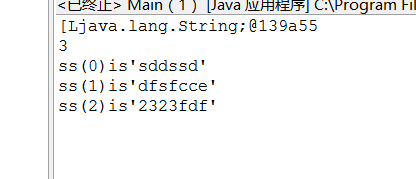





























 5173
5173











 被折叠的 条评论
为什么被折叠?
被折叠的 条评论
为什么被折叠?








